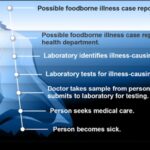The FDA has released two new tools in their foodborne illness investigations: EIS (Executive Incident Summary Abstracts) and FOOD (Foodborne Outbreak Overview of Data). The EIS will be released after an outbreak is over, providing high level information about the outbreak and any new information that may have been discovered since the investigation ended. FOOD is a comprehensive detailed report on product-pathogen pairs that have caused repeated outbreaks over the years. The EIS reports are written after the investigation into an FDA-regulated human food product is closed. The reports will be redacted to protect confidential information as well as personally identifiable information and other info that the Freedom of Information Act (FOIA) states is exempt from disclosure to the … [Read more...]
Idaho Illnesses Prompt Warnings About Unlicensed Vendors
Idaho illnesses have prompted the Idaho Central Health District into issuing warnings to consumers about unlicensed restaurants and unregulated food vendors. In the last few months, officials have received food poisoning complaints related to those facilities. Consumers are urged to use caution when purchasing foods from home vendors and to not visit unlicensed "underground" restaurants operated out of home kitchens. Environmental Health Program Manager Natasha Ferney said in a statement, "There are multiple risk factors in buying from unlicensed and unregulated vendors, but the most serious is the risk of foodborne illness. These vendors may not have a sanitary kitchen that meets provisions of the Idaho Food Code or know how to properly store or handle food to help prevent growth … [Read more...]
GAO Study of Foodborne Illness in U.S. Finds Issues
The Government Accounting Office (GAO) is responsible for examining how taxpayer dollars are spent and provides Congress and federal agencies with objective, non-partisan, fact-based information. It is an independent, non-partisan agency that works for Congress. The latest GAO study of foodborne illness in the United States has found some issues and recommends a national food safety strategy. The CDC states that only a small proportion of foodborne illnesses are diagnosed and reported to public health authorities every year. For Salmonella, only one case is reported for every 29 illnesses that actually occur. The report finds that the safety and quality of the U.S. food supply is covered by at least 30 federal laws administered by 25 agencies. Some goals aimed at reducing … [Read more...]
FDA Has Started a Streamlined Food Complaints Program
Have you ever wanted to tell the FDA about a problem with food? The FDA has started a streamlined food complaints program to make the process easier. The complaints can be about an illness, an injury, an allergic reaction, concerns about a dietary supplement, or any concern about defects in the safety or quality of an FDA-regulated food. This is part of the Human Foods Program. Until this new program was initiated, consumer complaints were directed to Consumer Complaint Coordinators in the FDA's Office of Regulatory Affairs. The phone numbers associated with those coordinators will no longer be active. Instead, consumers can call 1-888-SAFEFOOD (1-800-723-3663). Then, officials with the Human Foods Program will receive, triage, and evaluate complaints, and the new Office of … [Read more...]
McMaster Researchers Create Packaging Revealing Contamination
McMaster researchers have created food packaging that can reveal contamination of food, possibly helping prevent foodborne illness. Researchers Akansha Prasad, co-lead author of the paper that describes the invention, which was published in the journal Advanced Materials said in a statement, "This is something that can benefit everyone. We're hoping this technology will see lives, money, and food waste." Shadman Khan, co-lead author on the paper added, "We wanted to develop a system that was reliable, quick, affordable, and easy to use." The packaging will let producers, retailers, and consumers tell in real time whether the contents of a sealed food package are contaminated just by looking at it. Not having to open the package will eliminate the possibility of … [Read more...]
Foodborne Illness is Back to Pre-Pandemic Levels
Foodborne illness is back to pre-pandemic levels for some pathogens, according to research published in the Center for Disease Control and Prevention's Morbidity and Mortality Weekly Report (MMWR) for the week of June 30, 2023. The incidences that were higher were infections caused by Shiga toxin-producing E. coli, Yersinia, Vibrio, and cyclopsora. Campylobacter, Salmonella, Shigella, and Listeria illness levels did not change. In other words, progress in reducing enteric infection levels was not observed in 2022. The report states that collaboration among food growers, processors, retail stores, restaurants, and regulators is needed to reduce pathogen contamination during poultry slaughter and to prevent contamination of leafy greens. During the pandemic, foodborne … [Read more...]
Climate Change Increases Foodborne Illness Outbreak Risk
The effects of climate change are stark and worrying. Most people have heard about rising sea water levels, more wildfires, and more extreme weather events. But did you know that climate change increases foodborne illness outbreak risks? A study published in Scientific Reports by Kuhn et al looks at the relationship between Campylobacter outbreaks and climate in Northern Europe. The researchers used national surveillance data of campylobacteriosis infections in Denmark, Finland, Norway, and Sweden. They found that temperature, rainfall, and snowfall have a predictable effect on infection rates. Higher temperatures and heavier rainfall led to more infections, while shorter heatwaves and winter rain and snowfall reduced the number. Global climate change will change temperatures and … [Read more...]
Foodborne Illnesses Increased, Healthy People 2020 Targets Not Met
The Centers for Disease Control and Prevention Morbidity and Mortality Weekly Report has released information about incidence and trends of foodborne illness from their active surveillance network for 2016 - 2019. They have found that foodborne illnesses increased, so the Healthy People 2020 targets for reducing foodborne illness will not be met. In 2019, FoodNet identified 25,866 cases of infection, 6,164 hospitalizations, and 122 deaths. The overall incidence per 100,000 population was highest for Campylobacter, followed by Salmonella, STEC, Shigella, cyclospora, Yersinia, Vibrio, and Listeria. Eighty-six percent of infections were acquired domestically. It's important to note that most cases of foodborne illness are not reported to physicians, so those cases are not in the … [Read more...]
How Do You Know If You Have a Campylobacter Infection?
With the Center for Disease Control's Morbidity and Mortality Weekly Report report release detailing how foodborne illness increased by 65% in 2018 compared to 2015-2017, people are starting to think about the bacteria Campylobacter. This pathogen was the most common cause of bacterial foodborne illness in the United States in 2018, causing 19.5 illnesses per 100,000 people. How do you know if you have a Campylobacter infection? Most of these cases are not part of outbreaks, which are defined as two or more unrelated people sickened by the same strain of pathogen. About 14 cases are diagnosed per 100,000 people in this country every year. About 1,300,000 Americans are sickened by Campylobacter every year. In 2015, a Campylobacter outbreak in Northern California was associated … [Read more...]
Foodborne Illnesses Increased in 2018 Compared to 2015-2017
Foodborne illnesses increased in 2018 compared to the period of 2015-2017, according to a new report by the Center for Disease Control for its Weekly Morbidity and Mortality Report for the week of April 26, 2019. The report states that this increase may are partially attributable to increased culture-independent diagnostic tests (CIDTs). CIDT identifies pathogens that were not routinely detected by other methods. During 2018, FoodNet identified 25,606 infections, 5,893 hospitalizations, and 120 deaths. The incidence of cyclospora infections increased "markedly," in 2018 because there were several large outbreaks associated with produce. And the number of illnesses caused by Campylobacter and Salmonella remain high. FoodNet surveils the population for lab-diagnosed infections … [Read more...]












